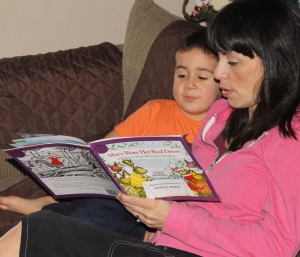 Preschool is an exciting time for young kiddos. Along with the fun of meeting new friends comes the task of learning many new things. Reading and writing are core subjects that will build a strong foundation for learning for your child. You can help build that foundation with these 4 tips:
Preschool is an exciting time for young kiddos. Along with the fun of meeting new friends comes the task of learning many new things. Reading and writing are core subjects that will build a strong foundation for learning for your child. You can help build that foundation with these 4 tips:
1. Talk, recite, and sing!
Preparation for reading begins with knowledge of a broad range of vocabulary. Children learn words by hearing them, so talk to them about what you’re doing and thinking, where you’re going, and what you see. Your child will begin to understand new ideas and concepts by hearing about and discussing events, objects, and places.
Work on expanding your child’s language. If he or she describes something as big, offer other words that mean the same, such as huge and enormous. As your child plays, use descriptive words that relate to what he or she is exploring. Ask open-ended questions throughout the day. Reciting poems, nursery rhymes, and finger plays and singing songs are other ways to expose your child to language. They make words fun and engaging with patterns of rhythm and rhyme!
2. Make books a staple.
Have books available for your child in many different places: in the car, in the living room, in his or her bedroom, and in the diaper bag or backpack. Include a variety of books, from board books to books with texture to non-fiction books with interesting, eye-catching  photographs. As you read to your child, take your time, show excitement, and use intonation (even during the 100th reading of the book). Your child will lose interest if you don’t seem interested or excited. Think of ways to add variety. Bring attention to the words on the page by pointing to them as you read. If your child is very familiar with the book, read the first part of a sentence and pause to see if he or she can finish it. Your child may enjoy “reading” the story to you. Consider using a puppet to tell the story. If the text of the book is too long, paraphrase the words or just talk about the pictures.
photographs. As you read to your child, take your time, show excitement, and use intonation (even during the 100th reading of the book). Your child will lose interest if you don’t seem interested or excited. Think of ways to add variety. Bring attention to the words on the page by pointing to them as you read. If your child is very familiar with the book, read the first part of a sentence and pause to see if he or she can finish it. Your child may enjoy “reading” the story to you. Consider using a puppet to tell the story. If the text of the book is too long, paraphrase the words or just talk about the pictures.
Be a literacy role model for your child. Throughout the day, you read menus, signs, cereal boxes, newspapers, magazines, instruction manuals, mail, etc. Explain what you are doing. For example, you might say, “I need to read the menu. It says…” or “I need to write down what we need at the store so we don’t forget anything.”
 3. Have paper and writing utensils available.
3. Have paper and writing utensils available.
Encourage your child to draw pictures (or simply make marks if he or she is very young) while you read aloud or tell a story from memory. Invite your child to “write” along with you while you pay bills or make your grocery list. Don’t forget to talk about what you are doing!
4. Don’t give into the pressure.
The pressure to meet or exceed benchmarks and acquire new skills has trickled down to our very youngest children. We must take care to ensure that our expectations of children are realistic. Children are natural learners. The most appropriate and effective thing we can do to help children succeed is to support their interests and efforts by providing a variety of opportunities and allowing them to learn at their own pace.
For children’s book suggestions (chosen by children) listed by age, check out the Children’s Book Council – Children’s Choices.
Back to blog listing